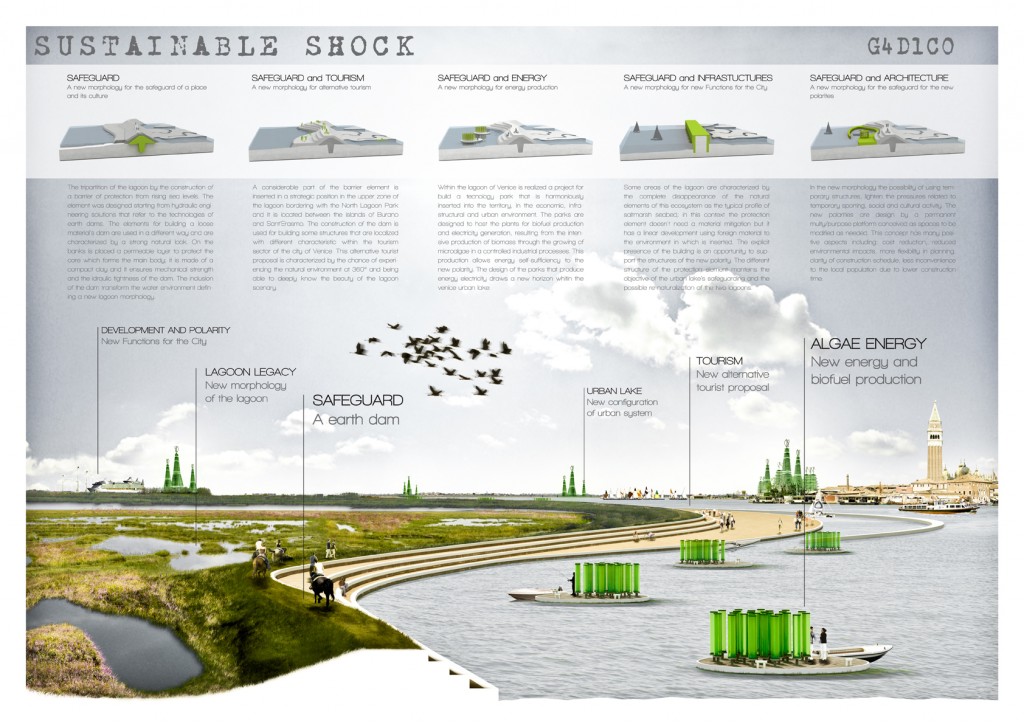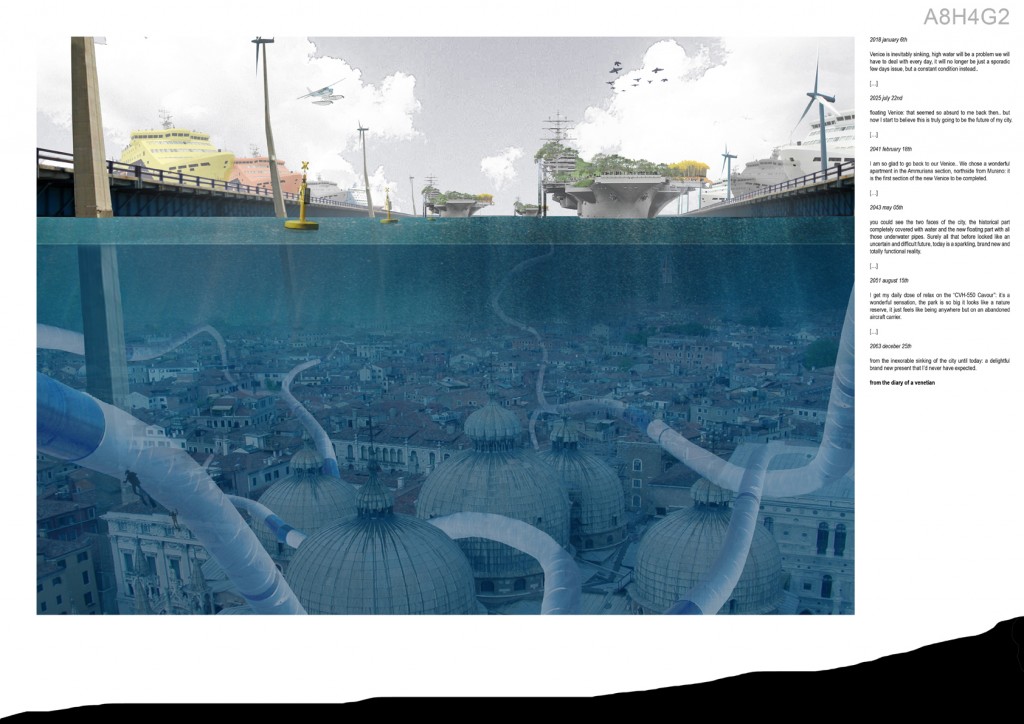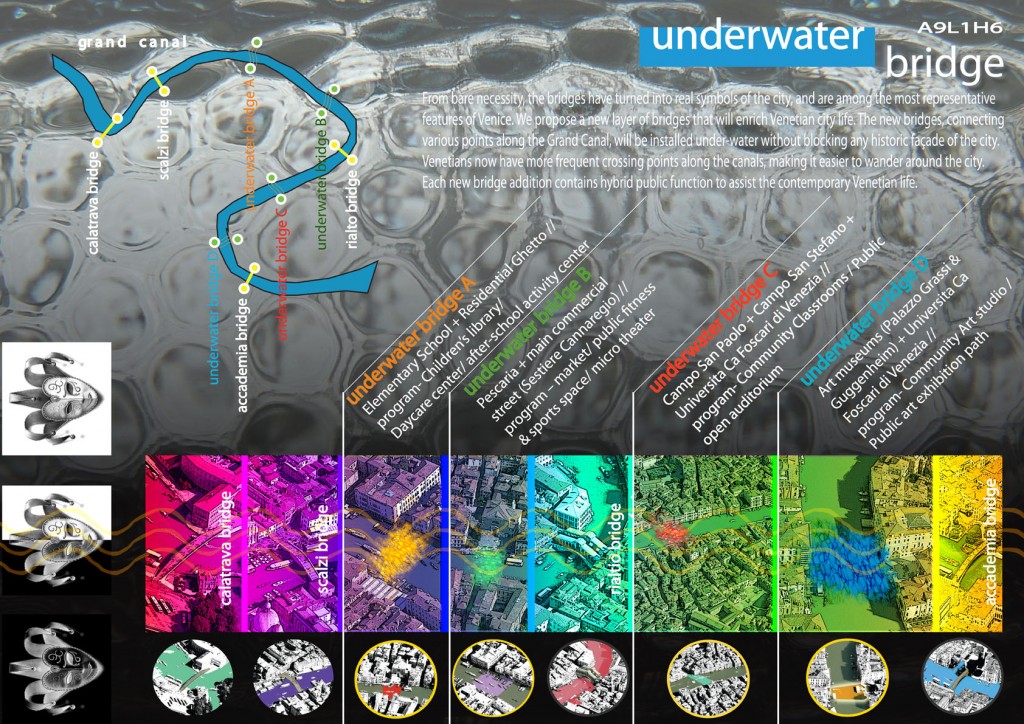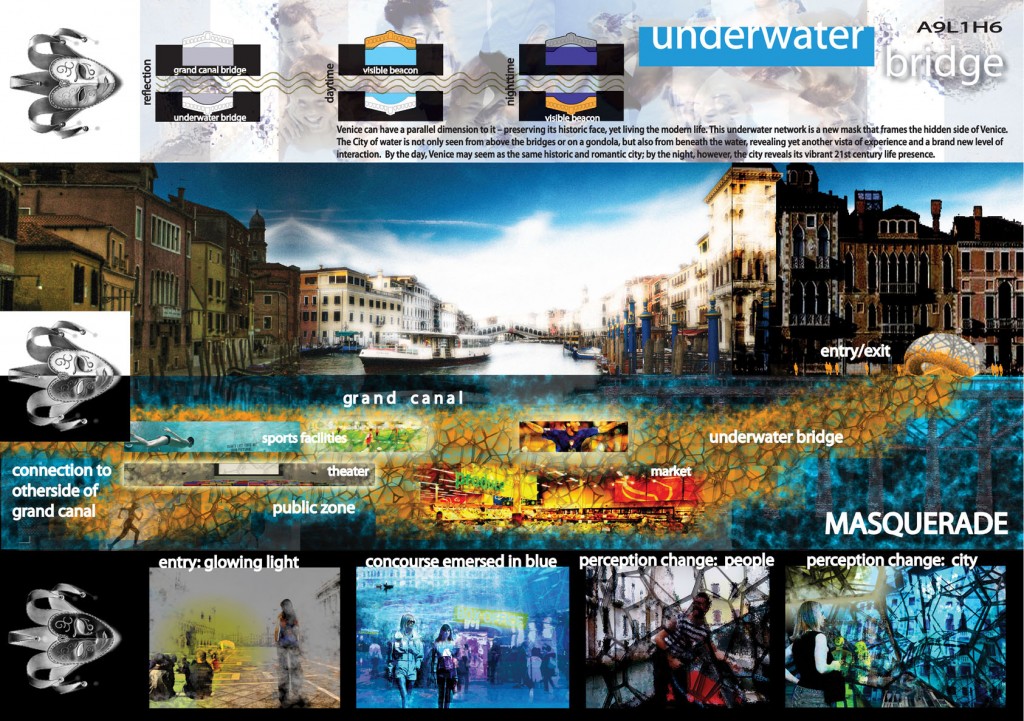Info:
Title: Underwater bridge - Code: A9L1H6Contest: Venice / 2011
By: M. Koo / A. Ahn
Views: 5347 Likes: 0
Votes:
BJARKE INGELS13 NERI OXMAN5 ELENA MANFERDINI3 MARIA LUDOVICA TRAMONTIN7 BOSTJAN VUGA15.8
Underwater bridge
Underwater Bridge Venetian Issue City of Venice boasts its remarkably rich and colorful cultural heritage. The city presents the visitors distinguished compilation of architecture, music, art, cuisine and festivals. The city’s unique sensation of water and unforgettable urban landscape still invokes the romantic sceneries of the European romanticism.
However, these very characteristics of the city have turned Venice into a quasi-theme park, rather than a modern metropolitan city. The map of Venice has remained essentially unchanged since the medieval times. The maze-like fabric of the city is made of complex patchwork of land and water, and is woven together by a massive network of bridge system. Venice’s unique water-based transportation system and bridge circulation have served as public art that attracts tourists from across the globe, but those have also impeded the advancement of necessary speed/pace and convenience, of which modern city requires.
Bridges
Bridges have served as an important piece of infrastructure throughout the history of Venice and its formation from multiple islands. Before bridges existed in Venice, the numerous islands were separate communities with their own churches, stores, and lifestyles. At one time, landowners even used planks as access from one island to the next and charged a small toll to those who wanted to cross over. It wasn’t until the 13th century that bridges were actually constructed in Venice. Once the bridges began connecting the islands, the city of Venice that we now know today began to form into one community. There are now over 435 bridges in the city, with at least one bridge crossing over each of the 182 canals in the city.
From bare necessity, the bridges have turned into real symbols of the city, and are among the most representative features of Venice. Each bridge, from the smallest to the more important ones, from the public to the private ones, gives something more to this city and offers unique sights to tourists and necessary on-foot circulation to residents.
Culture of Masquerade
The crowded narrow streets of 13th century Venice provided little or no privacy to those who lived there. The wearing of a masquerade mask, and the freedom and privacy it allowed, enabled the wearer to avoid public recognition and thus express themselves freely. Soon, all of the city’s residents were wearing masks to go about their daily lives. Putting on a mask instantly changed the perception between the subjects and the society. The act of wearing a mask concealed and transformed one’s identity. This allowed citizens of different social classes to be treated equally and prevented any form of inequality or prejudice. It became a city-wide opportunity for people from all walks of life to dress up and masquerade together in the magical streets of Venice.
Proposal
We propose a new layer of bridges that will enrich Venetian city life. The new bridges, connecting various points along the Grand Canal, will be installed under-water without blocking any historic façade of the city. Venetians now have more frequent crossing points along the canals, making it easier to wander around the city. New underwater connections will be installed near existing piazze, campi, or palazzi, where the location already bears the need for congested traffic relief. These new bridges will also house necessary community program spaces, such as community classroom, day care center, local library, mini fresh produce market, Cinema Theater, fitness center and etc.
Venice can have a parallel dimension to it – preserving its historic face, yet living the modern life. This underwater network is a new mask that frames the hidden side of Venice. The City of water is not only seen from above the bridges or on a gondola, but also from beneath the water, revealing yet another vista of experience and a brand new level of interaction.
Each new bridge addition contains hybrid public function to assist the contemporary Venetian life.
Near the residential Ghetto neighborhood, children’s educational spaces will be placed to aid elementary school program; near Pescaria market, a screening theater and public fitness zone will be placed to encourage communal activities; near Universita Ca Foscari community classrooms will be placed to expand continuing education needs; lastly, near Palazzo Grassi and other art museums, art studios and exhibition space for the resident artists will be placed.
The bridges are to be constructed with shaped Glass/ EFTE and Fiberglass occupiable space frame. Transparent material and open structural system allows clear view of Venice from underwater. Shaped glass creates visual illusions with light, color, and view frame. Arc, circle, and sphere are shapes that spread out pressure evenly, and will be used in forming concrete occupiable space frame structure where the shaped glass pieces will be fitted.
By the day, Venice may seem as the same historic and romantic city; by the night, however, the city reveals its vibrant 21st century life presence.
“Cities, like dreams, are made of desires and fears, even if the thread of their discourse is secret, their rules are absurd, their perspectives deceitful, and everything conceals something else.”
Italo Calvino
Info:
Title: Underwater bridge
Time: 7 giugno 2011
Category: Venice
Views: 5347 Likes: 0
Tags: Bridge , City of Water , Grand Canal , Italo Calvino , New York City , Palazzo Grassi , Technology , Venice








